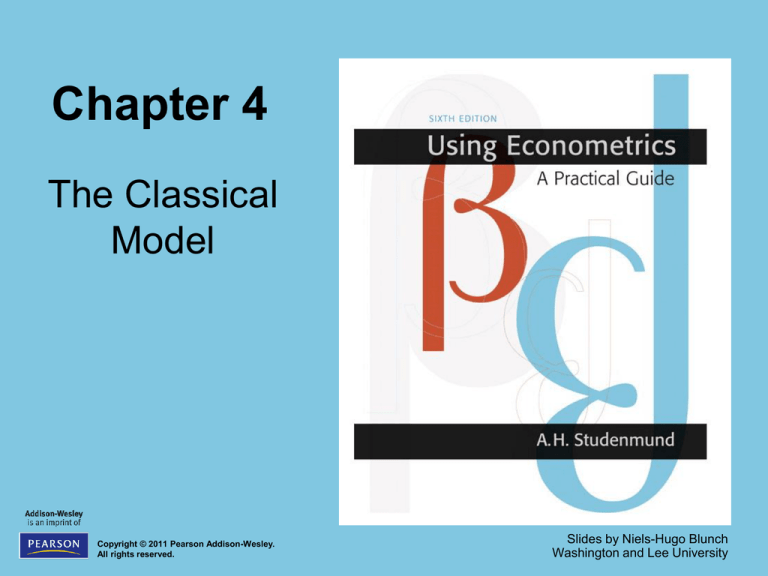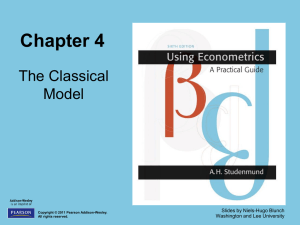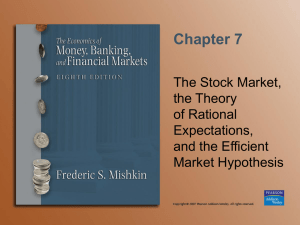
Chapter 4
The Classical
Model
Copyright © 2011 Pearson Addison-Wesley.
All rights reserved.
Slides by Niels-Hugo Blunch
Washington and Lee University
The Classical Assumptions
•
•
The classical assumptions must be met in order for OLS estimators to be the
best available
The seven classical assumptions are:
I. The regression model is linear, is correctly specified, and has an
additive error term
II. The error term has a zero population mean
III. All explanatory variables are uncorrelated with the error term
IV. Observations of the error term are uncorrelated with each other
(no serial correlation)
V. The error term has a constant variance (no heteroskedasticity)
VI. No explanatory variable is a perfect linear function of any other
explanatory variable(s) (no perfect multicollinearity)
VII. The error term is normally distributed (this assumption is optional
but usually is invoked)
© 2011 Pearson Addison-Wesley. All rights reserved.
4-1
I: linear, correctly specified,
additive error term
• Consider the following regression model:
Yi = β0 + β1X1i + β2X2i + ... + βKXKi + εi
(4.1)
• This model:
– is linear (in the coefficients)
– has an additive error term
• If we also assume that all the relevant explanatory variables
are included in (4.1) then the model is also correctly
specified
© 2011 Pearson Addison-Wesley. All rights reserved.
4-2
II: Error term has a zero
population mean
• As was pointed out in Section 1.2, econometricians add a
stochastic (random) error term to regression equations
• Reason: to account for variation in the dependent
variable that is not explained by the model
• The specific value of the error term for each observation
is determined purely by chance
• This can be illustrated by Figure 4.1
© 2011 Pearson Addison-Wesley. All rights reserved.
4-3
Figure 4.1 An Error Term
Distribution with a Mean of Zero
© 2011 Pearson Addison-Wesley. All rights reserved.
4-4
III: All explanatory variables are
uncorrelated with the error term
• If not, the OLS estimates would be likely to attribute to
the X some of the variation in Y that actually came from
the error term
• For example, if the error term and X were positively
correlated then the estimated coefficient would probably
be higher than it would otherwise have been (biased
upward)
• This assumption is violated most frequently when a
researcher omits an important independent variable from
an equation
© 2011 Pearson Addison-Wesley. All rights reserved.
4-5
IV: No serial correlation of
error term
• If a systematic correlation does exist between one observation of
the error term and another, then it will be more difficult for OLS to
get accurate estimates of the standard errors of the coefficients
• This assumption is most likely to be violated in time-series
models:
– An increase in the error term in one time period (a random shock,
for example) is likely to be followed by an increase in the next
period, also
– Example: Hurricane Katrina
• If, over all the observations of the sample εt+1 is correlated with εt then
the error term is said to be serially correlated (or auto-correlated),
and Assumption IV is violated
• Violations of this assumption are considered in more detail in Chapter 9
© 2011 Pearson Addison-Wesley. All rights reserved.
4-6
V: Constant variance / No
heteroskedasticity in error term
• The error term must have a constant variance
• That is, the variance of the error term cannot
change for each observation or range of
observations
• If it does, there is heteroskedasticity present in the
error term
• An example of this can bee seen from Figure 4.2
© 2011 Pearson Addison-Wesley. All rights reserved.
4-7
Figure 4.2 An Error Term Whose
Variance Increases as Z Increases
(Heteroskedasticity)
© 2011 Pearson Addison-Wesley. All rights reserved.
4-8
VI: No perfect multicollinearity
• Perfect collinearity between two independent variables
implies that:
– they are really the same variable, or
– one is a multiple of the other, and/or
– that a constant has been added to one of the variables
• Example:
– Including both annual sales (in dollars) and the annual sales tax
paid in a regression at the level of an individual store, all in the
same city
– Since the stores are all in the same city, there is no variation in the
percentage sales tax
© 2011 Pearson Addison-Wesley. All rights reserved.
4-9
VII: The error term is normally
distributed
• Basically implies that the error term follows a
bell-shape (see Figure 4.3)
• Strictly speaking not required for OLS estimation
(related to the Gauss-Markov Theorem: more on
this in Section 4.3)
• Its major application is in hypothesis testing,
which uses the estimated regression coefficient to
investigate hypotheses about economic behavior
(see Chapter 5)
© 2011 Pearson Addison-Wesley. All rights reserved.
4-10
Figure 4.3
Normal Distributions
© 2011 Pearson Addison-Wesley. All rights reserved.
4-11
The Sampling
Distribution of
• We saw earlier that the error term follows a
probability distribution (Classical Assumption VII)
• But so do the estimates of β!
– The probability distribution of these values across
different samples is called the sampling distribution
of
• We will now look at the properties of the mean, the
variance, and the standard error of this sampling
distribution
© 2011 Pearson Addison-Wesley. All rights reserved.
4-12
Properties of the Mean
• A desirable property of a distribution of estimates in that its mean
equals the true mean of the variables being estimated
• Formally, an estimator is an unbiased estimator if its sampling
distribution has as its expected value the true value of .
• We also write this as follows:
(4.9)
• Similarly, if this is not the case, we say that the estimator is
biased
© 2011 Pearson Addison-Wesley. All rights reserved.
4-13
Properties of the Variance
• Just as we wanted the mean of the sampling distribution to be
centered around the true population , so too it is desirable for
the sampling distribution to be as narrow (or precise) as possible.
– Centering around “the truth” but with high variability might be of very
little use.
• One way of narrowing the sampling distribution is to increase the
sampling size (which therefore also increases the degrees of
freedom)
• These points are illustrated in Figures 4.4 and 4.5
© 2011 Pearson Addison-Wesley. All rights reserved.
4-14
Figure 4.4
Distributions of
© 2011 Pearson Addison-Wesley. All rights reserved.
4-15
Figure 4.5 Sampling Distribution of
for Various Observations (N)
© 2011 Pearson Addison-Wesley. All rights reserved.
4-16
Properties of the
Standard Error
• The standard error of the estimated coefficient, SE( ),
is the square root of the estimated variance of the
estimated coefficients.
• Hence, it is similarly affected by the sample size and
the other factors discussed previously
– For example, an increase in the sample size will decrease the
standard error
– Similarly, the larger the sample, the more precise the
coefficient estimates will be
© 2011 Pearson Addison-Wesley. All rights reserved.
4-17
The Gauss-Markov Theorem and
the Properties of OLS Estimators
• The Gauss-Markov Theorem states that:
– Given Classical Assumptions I through VI (Assumption VII,
normality, is not needed for this theorem), the Ordinary Least
Squares estimator of –k is the minimum variance estimator
from among the set of all linear unbiased estimators of –k,
for k = 0, 1, 2, …, K
• We also say that “OLS is BLUE”: “Best (meaning
minimum variance) Linear Unbiased Estimator”
© 2011 Pearson Addison-Wesley. All rights reserved.
4-18
The Gauss-Markov Theorem and the
Properties of OLS Estimators (cont.)
• The Gauss-Markov Theorem only requires the first six classical
assumptions
• If we add the seventh condition, normality, the OLS coefficient
estimators can be shown to have the following properties:
– Unbiased: the OLS estimates coefficients are centered around the true
population values
– Minimum variance: no other unbiased estimator has a lower variance for
each estimated coefficient than OLS
– Consistent: as the sample size gets larger, the variance gets smaller, and
each estimate approaches the true value of the coefficient being estimated
– Normally distributed: when the error term is normally distributed, so are
the estimated coefficients—which enables various statistical tests requiring
normality to be applied (we’ll get back to this in Chapter 5)
© 2011 Pearson Addison-Wesley. All rights reserved.
4-19
Table 4.1a
Notation Conventions
© 2011 Pearson Addison-Wesley. All rights reserved.
4-20
Table 4.1b
Notation Conventions
© 2011 Pearson Addison-Wesley. All rights reserved.
4-21
Key Terms from Chapter 4
• The classical assumptions
• Classical error term
• Standard normal distribution
• SE( ),
• Unbiased estimator
• BLUE
• Sampling distribution
© 2011 Pearson Addison-Wesley. All rights reserved.
4-22








